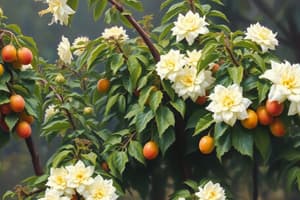Podcast
Questions and Answers
Which category do vegetables like lettuce, spinach, and kale belong to?
Which category do vegetables like lettuce, spinach, and kale belong to?
- Root vegetables
- Leafy greens (correct)
- Stem vegetables
- Legumes
Which type of vegetable does a sweet potato belong to?
Which type of vegetable does a sweet potato belong to?
- Tubers (correct)
- Stem Vegetables
- Bulbs
- Fruiting Vines
What type of vegetable are cucumbers, zucchinis, and squashes classified as?
What type of vegetable are cucumbers, zucchinis, and squashes classified as?
- Bulbs
- Fruiting Vines (correct)
- Root vegetables
- Leafy greens
What are common challenges faced by growers in vegetable cultivation?
What are common challenges faced by growers in vegetable cultivation?
Which vegetable is known for being susceptible to diseases and pests that threaten its marketability?
Which vegetable is known for being susceptible to diseases and pests that threaten its marketability?
What is a method commonly used by growers to mitigate threats from insect pests and pathogens in vegetable production?
What is a method commonly used by growers to mitigate threats from insect pests and pathogens in vegetable production?
Which of the following is an example of a biological control agent used in vegetable production?
Which of the following is an example of a biological control agent used in vegetable production?
What strategy can growers employ to make it difficult for pests and diseases to thrive in vegetable crops?
What strategy can growers employ to make it difficult for pests and diseases to thrive in vegetable crops?
In integrated pest management (IPM), what is the primary focus when managing pests in vegetable crops?
In integrated pest management (IPM), what is the primary focus when managing pests in vegetable crops?
Why is it important for growers to understand local regulations before applying chemical controls in vegetable production?
Why is it important for growers to understand local regulations before applying chemical controls in vegetable production?
Flashcards are hidden until you start studying
Study Notes
Vegetable Crop in Horticulture
Vegetables play a vital role in human nutrition, providing essential vitamins, minerals, fiber, and antioxidants. This section will explore various facets of vegetable crops within the realm of horticulture, including diverse species, common challenges faced by growers, and strategies to combat them.
Types of Vegetables
Hundreds of edible plant species fall under the umbrella term 'vegetables,' which can be broadly categorized into leafy greens, root vegetables, legumes, fruiting vines, bulbs, tubers, and stem vegetables. Some popular examples from these categories include:
- Leafy Greens: Lettuce, spinach, kale, collard greens, Swiss chard
- Root Vegetables: Carrot, potato, radish, turnip, beetroot
- Legumes: Peas, beans, lentils, chickpeas
- Fruiting Vines: Cucumber, zucchini, squash, pumpkin
- Bulbs: Onion, garlic, leek
- Tubers: Sweet potatoes, Jerusalem artichokes
- Stem Vegetables: Celery, broccoli stems, rhubarb stalks
The above list is just a starting point; there's a wealth of food sources yet to discover!
Challenges Faced by Growers
Agronomic pursuits involving vegetable cultivation face several obstacles, among them being disease and pest infestations. These issues threaten crop yield, quality, and marketability. Insect pests and pathogens commonly encountered in vegetable production include:
- Spotted cucumber beetles
- Aphids
- Flea beetles
- Powdery mildew
- Downy mildew
- Bacterial wilt
- Anthracnose
- Early and late blight
To mitigate these threats, growers must adopt preventive measures such as sanitation practices, crop rotation, biological control agents, and chemical treatments when needed.
Strategies against Diseases and Pests
Though the eradication of all pathogens is unlikely, the implementation of integrated pest management (IPM) approaches helps minimize damage while preserving natural systems. IPM encompasses a variety of tactics designed to manage pests effectively with minimal risk to humans, non-target organisms, and the environment. Here are some primary methods utilized to protect vegetable crops:
Biological Control Agents
Biological control agents refer to living organisms used instead of chemicals to regulate populations of target pests and diseases. They offer cost-effective solutions without causing harm to beneficial insects or environmental contamination. Examples include predatory parasitoids, entomopathogenic fungi, nematodes, and microorganisms like bacteria and viruses.
Cultural Practices
Cultural practices involve growing methods that promote healthy plants and make it difficult for pests and diseases to thrive. Methods include proper seed selection, soil preparation, irrigation techniques, optimal spacing between crops, crop rotations, and timely removal of debris and diseased material from fields after harvest.
Chemical Controls
In certain cases, the judicious application of approved chemical controls might be necessary to safeguard vegetable crops when other options fail or prove insufficient. Before applying any chemical product, it's crucial to understand local regulations and best practice guidelines to ensure responsible usage.
By understanding the diverse taxonomy of vegetables, anticipating potential hurdles posed by diseases and pests, and employing appropriate prevention strategies, growers worldwide can successfully produce safe and nutritious fruits and vegetables for consumers.
Studying That Suits You
Use AI to generate personalized quizzes and flashcards to suit your learning preferences.




